
Tuia Mātauranga pukapuka mahi | activity book — junior
Use the activities in this book to discover more about yourself, and Aotearoa New Zealand and its histories. Download and print the book or read the online version on this page to help you do the activities.
Download and print the book: Tuia Mātauranga pukapuka mahi | activity book — junior (pdf, 2.7 MB).
Read the accessible, online version below. Note that you may need a printed copy of the activity book to do some of the activities.
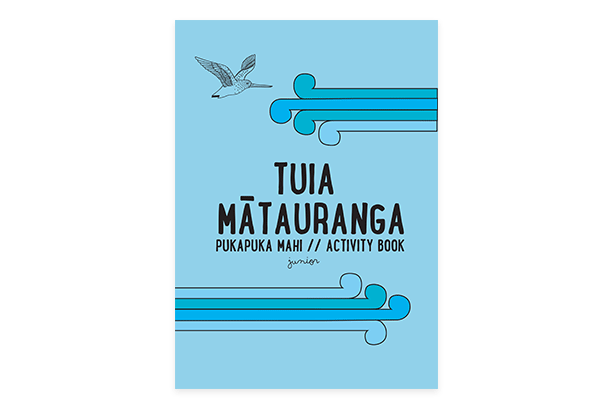
Kia ora, me and my whānau
Kia ora
I’m Kuaka the Explorer.
Way back, Pacific peoples followed me all the way to Aotearoa New Zealand. I know my way around, all right!
Come with me on a new adventure and find out what makes you, you.
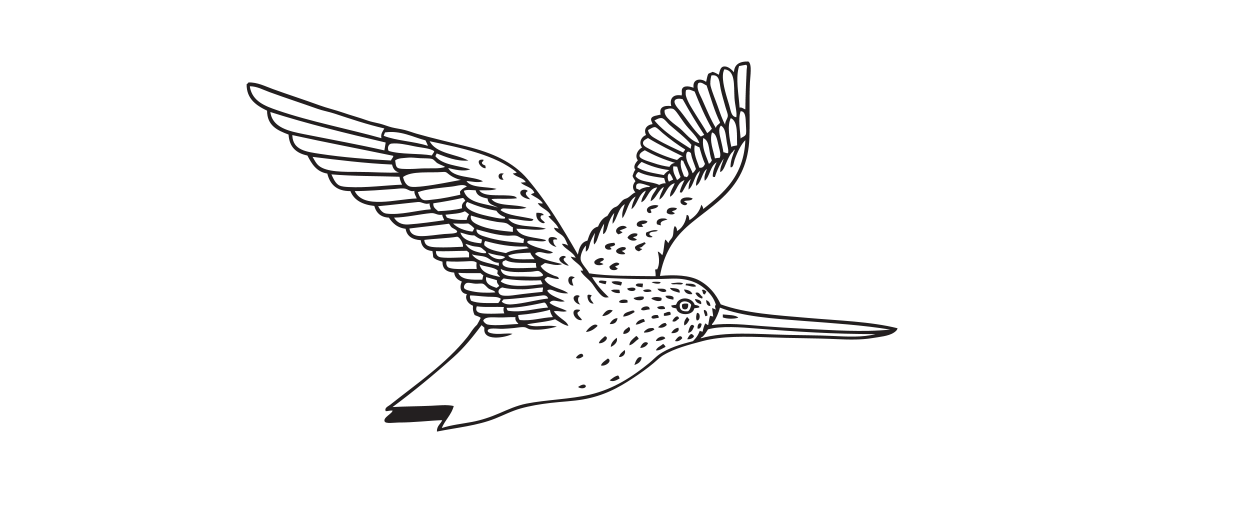
Activity
Draw your own kuaka.
This is me and my whānau
Tell us a bit about you and your whānau, what are some characteristics about your whānau that people might not know of that you like in particular.
Activity
Sketch yourself with your whanau!
A name is a gift given to identify who you are. How we got our name can tell a story.
Find out the story of your name. Complete these sentences:
My name is …
My surname is from …
My family comes from …
Tōku pepeha — about me
Complete these sentences:
Ko … te maunga. (My mountain is …)
Ko … te awa/roto/moana. (My river/lake/sea is …)
Ko … te waka. (My waka is …)
Ko … te iwi. (My tribe is …)
Ko … te whānau. (My family is …)
Nō … ahau. (I am from …)
Glossary
maunga — mountain
awa — river
waka — waka
iwi — tribe
roto — lake
moana — sea
kāinga — home
whānau — family.
Pacific travellers and Matariki
Waka hourua — Pacific sailing canoes
Waka hourua have two hulls and two masts. Strong and sturdy.
Every part of the waka hourua was tied in place — no nails or bolts.
Activity
Join the dots, then name the parts:
pou manawa — mast
hiwi — hull
kiato — cross-beam
manawa — mast step
papa noho — deck
rauawa — gunwales
kei — stern
ihu — prow
rā matua — mainsail
rā taunaki — mizzen
hoe tere — steering oar.
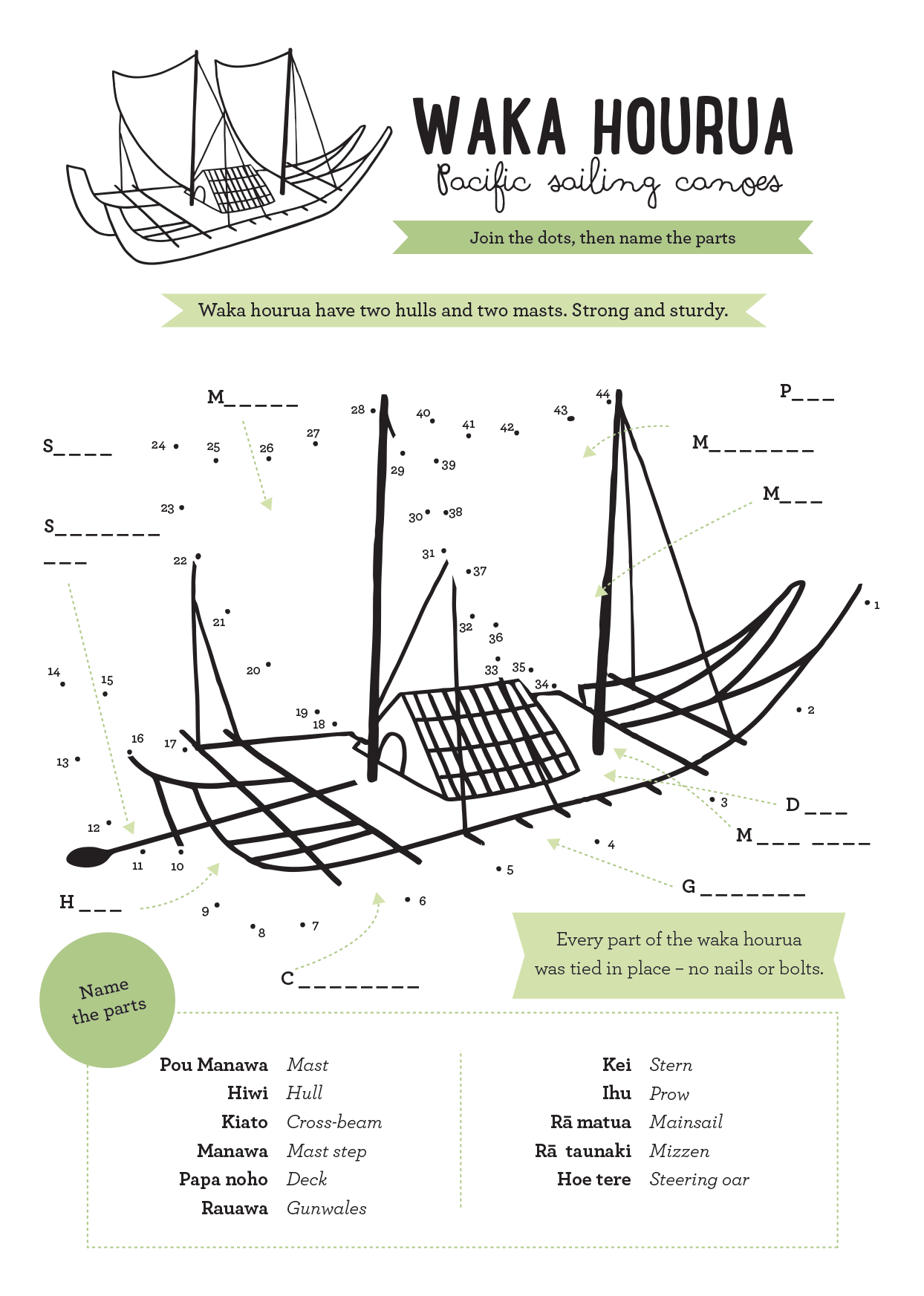
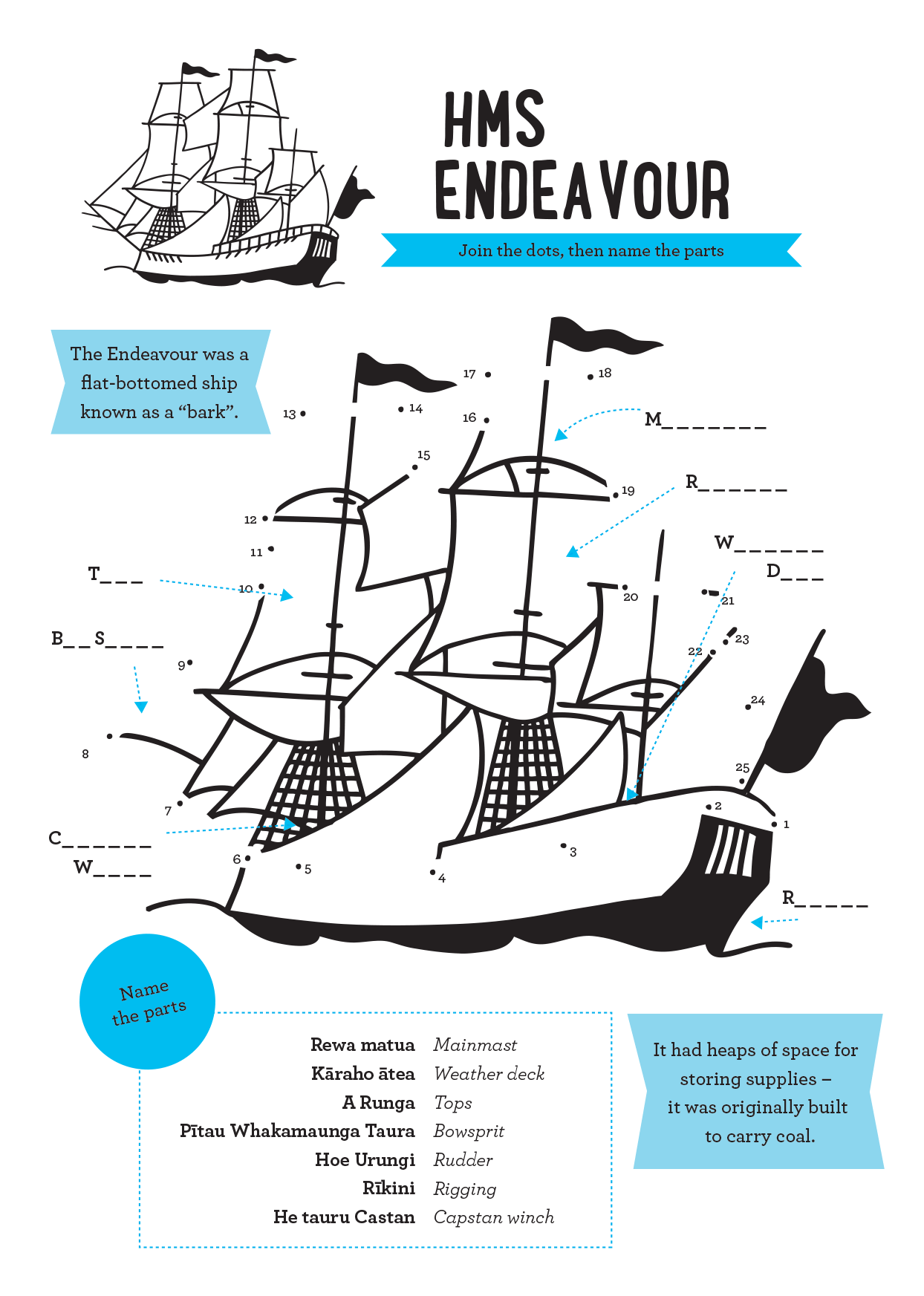
HMS Endeavour
The Endeavour was a flat-bottomed ship known as a ‘bark’.
It had heaps of space for storing supplies — it was originally built to carry coal.
Activity
Join the dots, then name the parts:
rewa matua — mainmast
kāraho ātea — weather deck
a runga — tops
pītau whakamaunga taura — bowsprit
hoe urungi — rudder
rīkini — rigging
he tauru castan — capstan winch.
Star compass
Pacific navigators use a compass like this to help them memorise where stars rise and set.
Activity
Colour in each of the ‘quarters’.
The ‘quarters’ of the compass are named after the four winds:
Tokerau
Marangai
Whakarunga
Whakararo.
Whare (house) within each ‘quarter’:
Rā
Kāinga
Ngoi
Manu
Ngā Rangi
Ngā Reo
Haka.
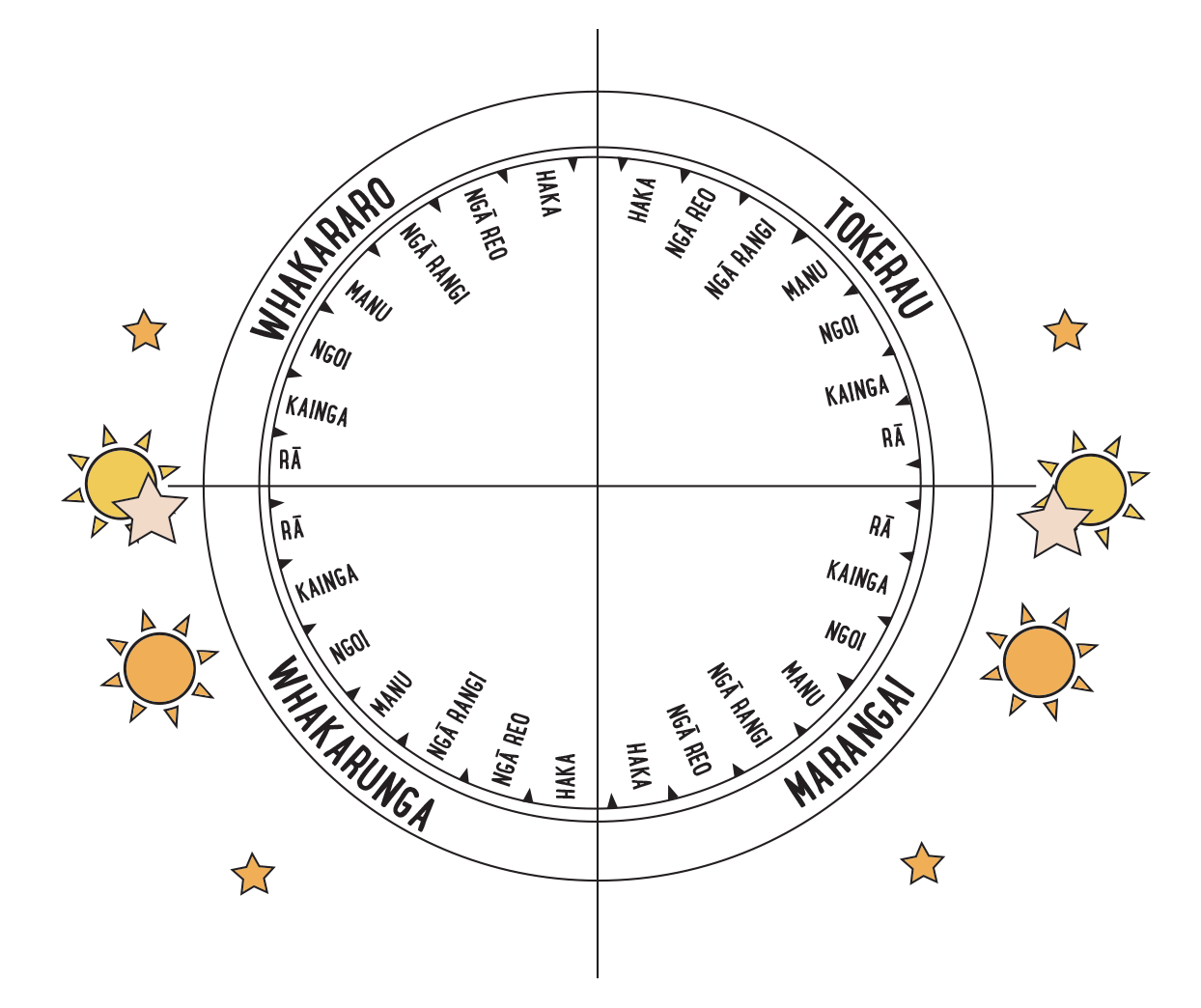
Matariki
Matariki is the star cluster that rises at the start of the Māori New Year in midwinter. It’s also a celebration of the past and future — a time to tell stories and plan ahead.
Draw a face that suits the character of each star:
Ururangi
Waipunarangi
Waitā
Hiwa-i-te-rangi
Waitā
Waitī
Pōhutukawa
Tupu-ā-rangi
Matariki
Tupu-ā-nuku.
Tupu-ā-nuku — is a gardener.
Tupu-ā-rangi — loves to sing.
Waipunarangi — watches over the oceans, lakes, and rivers, preparing Tangaroa’s children to feed the people.
Waitī — oversees the domain of freshwater.
Waitā — oversees the domain of saltwater.
Ururangi — gives Papatūānuku hugs, to warm her after the cold and dark of winter.
Matariki — helps all her daughters to do their very best.
Some say there are two additional stars in Matariki:
Pōhutukawa — guides those who have passed on.
Hiwa-i-te-rangi — leaves us with hope for the year ahead.
Kupe explores Aotearoa
The great explorer Kupe was the first person to name parts of Aotearoa — from the bottom of the South Island to Hokianga in the north. These names live on, nearly 1,000 years later!
Activity
Use Morse code to name the location:
- / . / -- / .- / -. / .- / --- / -.- / ..- / .--. / . / -.- / .. / - / . / -- / --- / .- / -. / .- / -. / ..- / .. / .- / -.- / .. / .-- / .-
Key:
A: .-
B: -...
C: -.-.
D: -..
E: .
F: ..-.
G: --.
H: ....
I: ..
J: .---
K: -.-
L: .-..
M: --
N: -.
O: ---
P: .--.
Q: --.-
R: .-.
S: ...
T: -
U: ..-
V: ...-
W: .--
X: -..-
Y: -.--
Z: --..
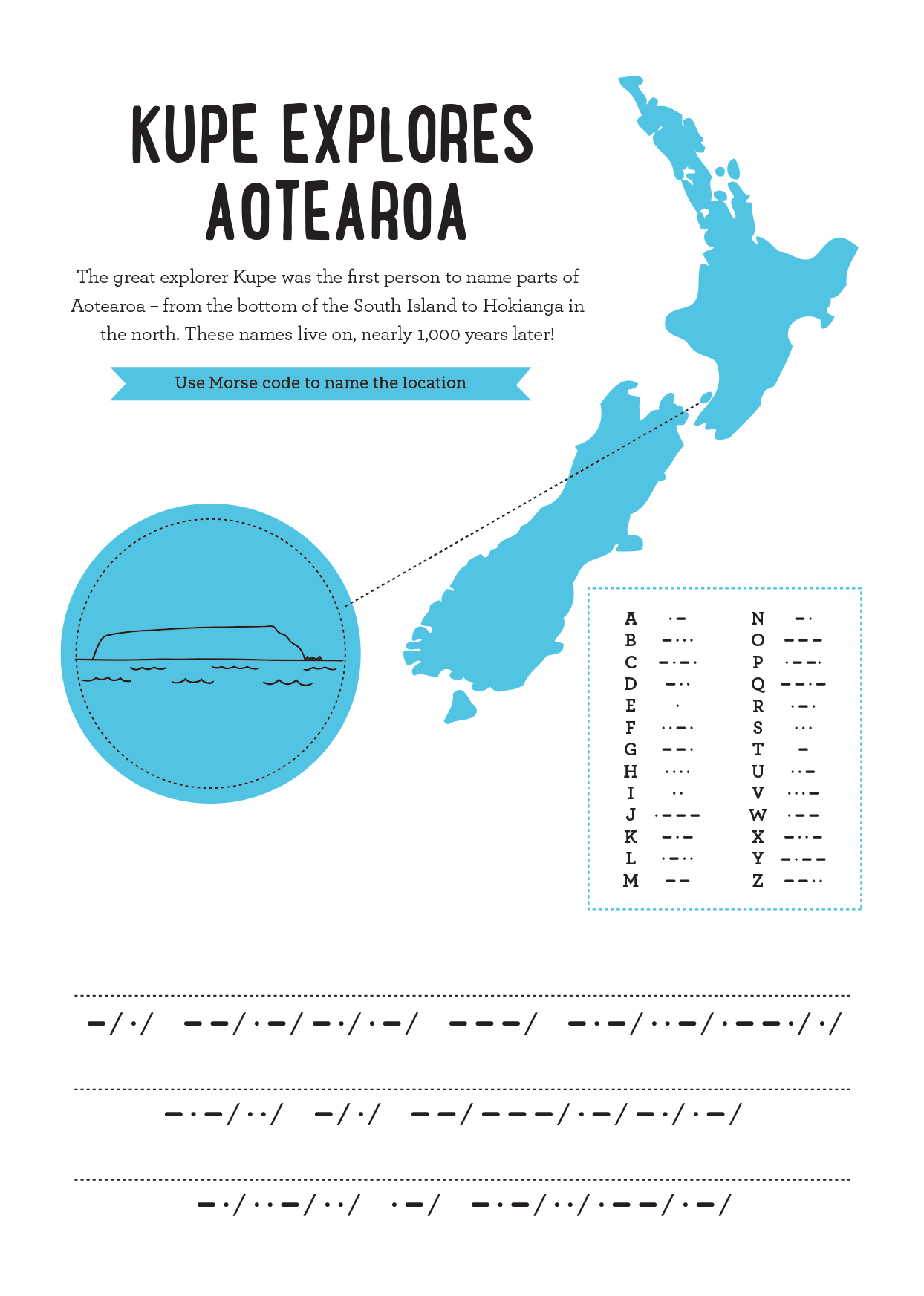
The waka and ships
Activity
Draw your own waka and ships.
Ngahiraka mai Tawhiti
Haunui
Fa’afaite i te a Māohi
HMS Endeavour
R Tucker Thompson
Spirit of New Zealand.
Which waka for the job?
Waka come in many shapes and sizes. Some are made for travelling on oceans, and others are for taking short trips across rivers.
Look at these three waka:
waka taua
waka tiwai
waka hourua.
Write which one you think is good for:
carrying a big group of warriors
taking small groups of people up rivers
moving fast on the ocean.
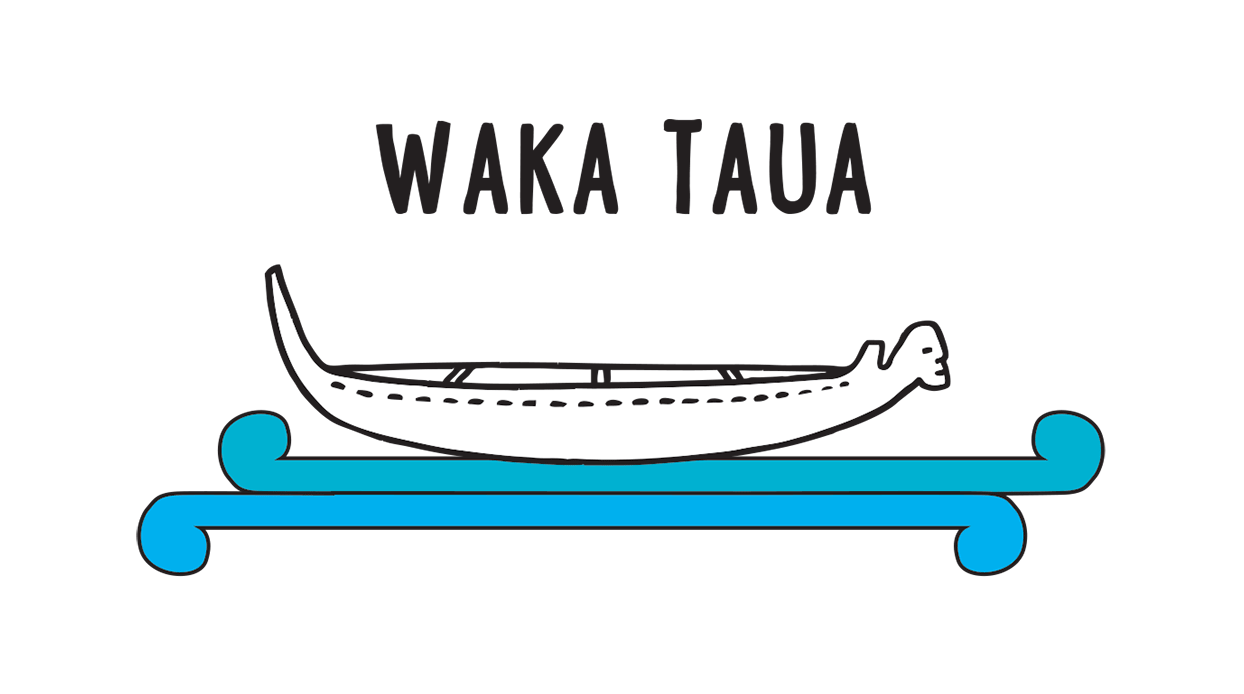
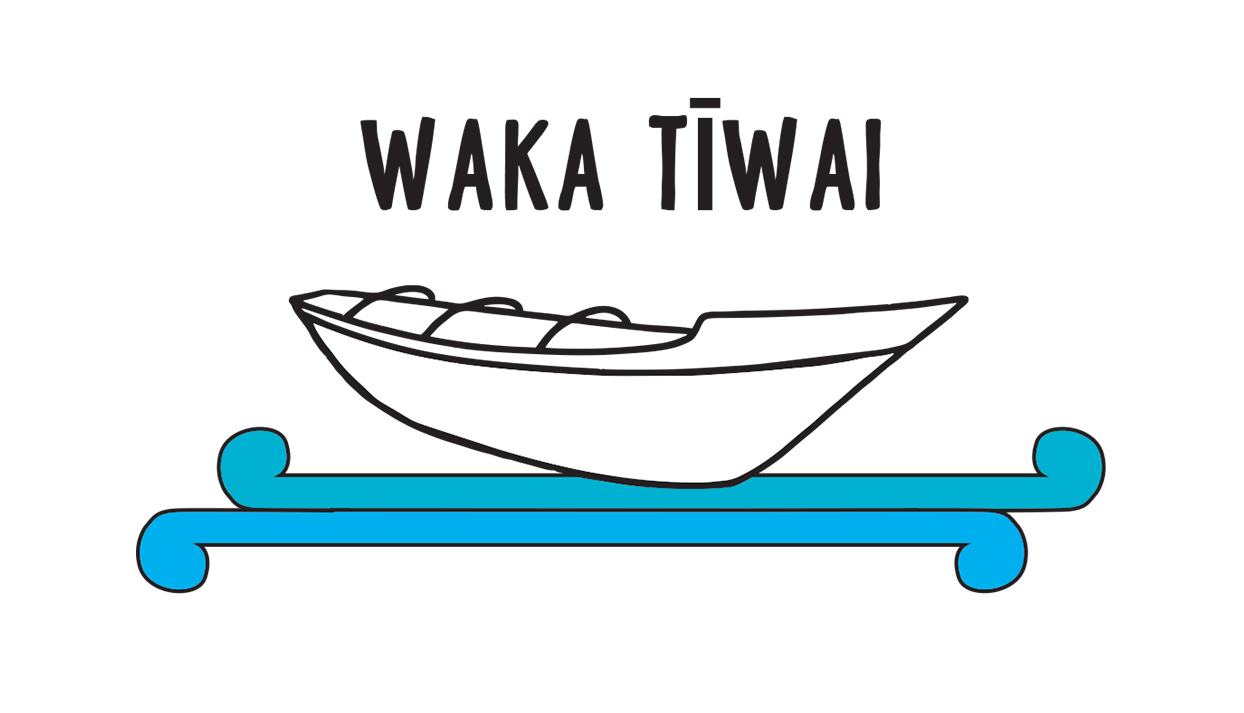
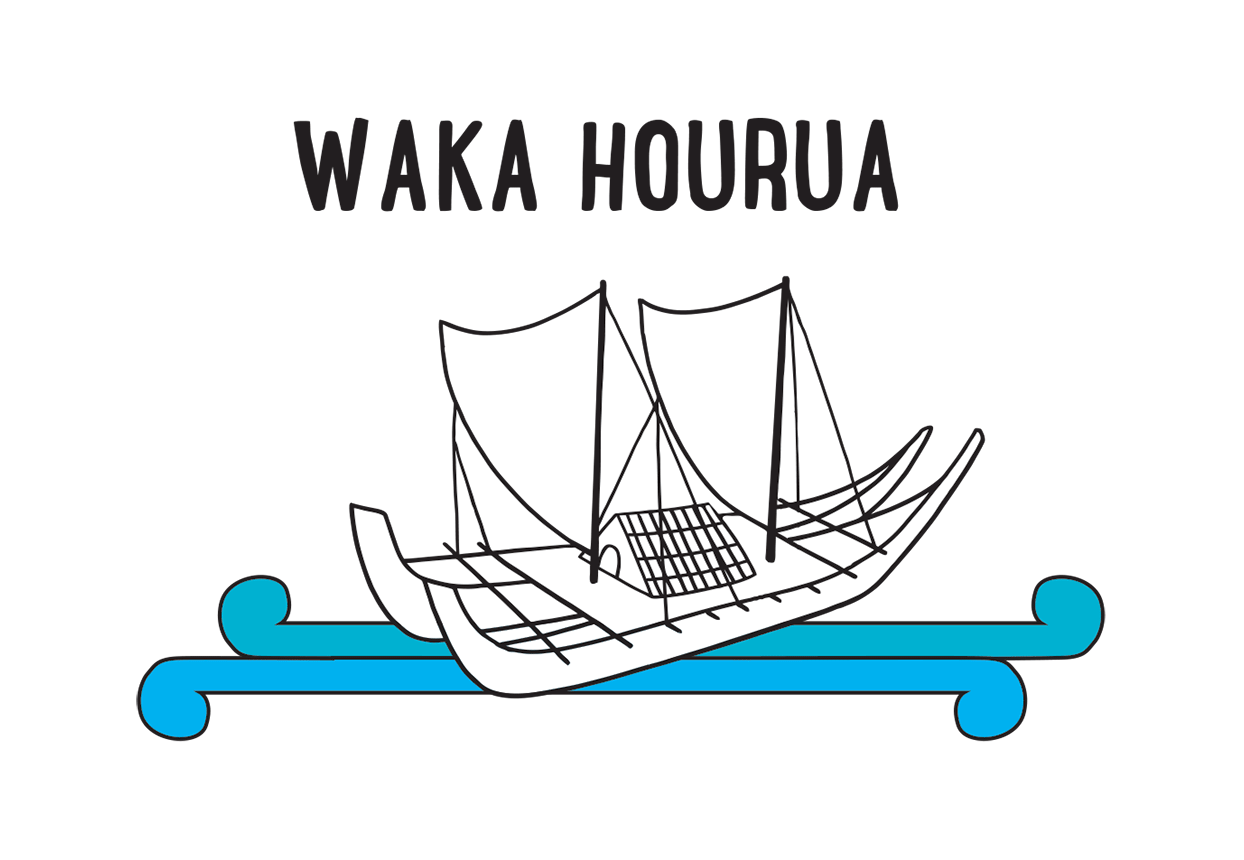
Kuaka
Kuaka (bar-tailed godwits) are amazing Pacific travellers.
Flying kuaka are known as ‘waka kuaka’.
Tens of thousands of kuaka flock to Aotearoa New Zealand in spring to rest and feed on our shores.
Activity
Draw your own kuaka.
Native animals, maramataka and plants
Our unique animals
Many animals found nowhere else have evolved in Aotearoa New Zealand, far from other lands.
Some are downright quirky!
Huia
These beautiful songbirds were treasured by Māori — only leaders could wear their white-tipped feathers. Huia were easy meals for mammals that arrived in the 1800s, and they soon became extinct.
Māui dolphin
They’re the tiniest marine dolphins in the world, just 1.5 metres long, with a round ‘Mickey Mouse ear’ dorsal fin. They get caught in fishing nets, and only about 60 adults are left.
Kākāpō
These heavy parrots can’t fly, and clamber up trees for food — sometimes, they fall off!
It is the world’s only night parrot. There are only about 200 kākāpō left. They’re cared for on protected islands.
Activity
Draw these three native animals: a huia, a Māui dolphin, and a kākāpō.
What’s one native animal that lives near you?
How can you help make sure it has enough food and a safe place to raise a family?
The maramataka
The maramataka is the Māori calendar, based on the cycles of the moon.
It tells you the best times to plant, harvest, hunt, and fish.
Takurua (winter) — it's cold! Draw your whānau sitting round a fire.
Kōanga (spring) — time to plant the garden. Draw your favourite fruits and veges.
Raumati (summer) — the sun's warm. Draw your favourite summer spot.
Ngahuru (autumn) — time to store food for winter. Draw where you'd keep it all.
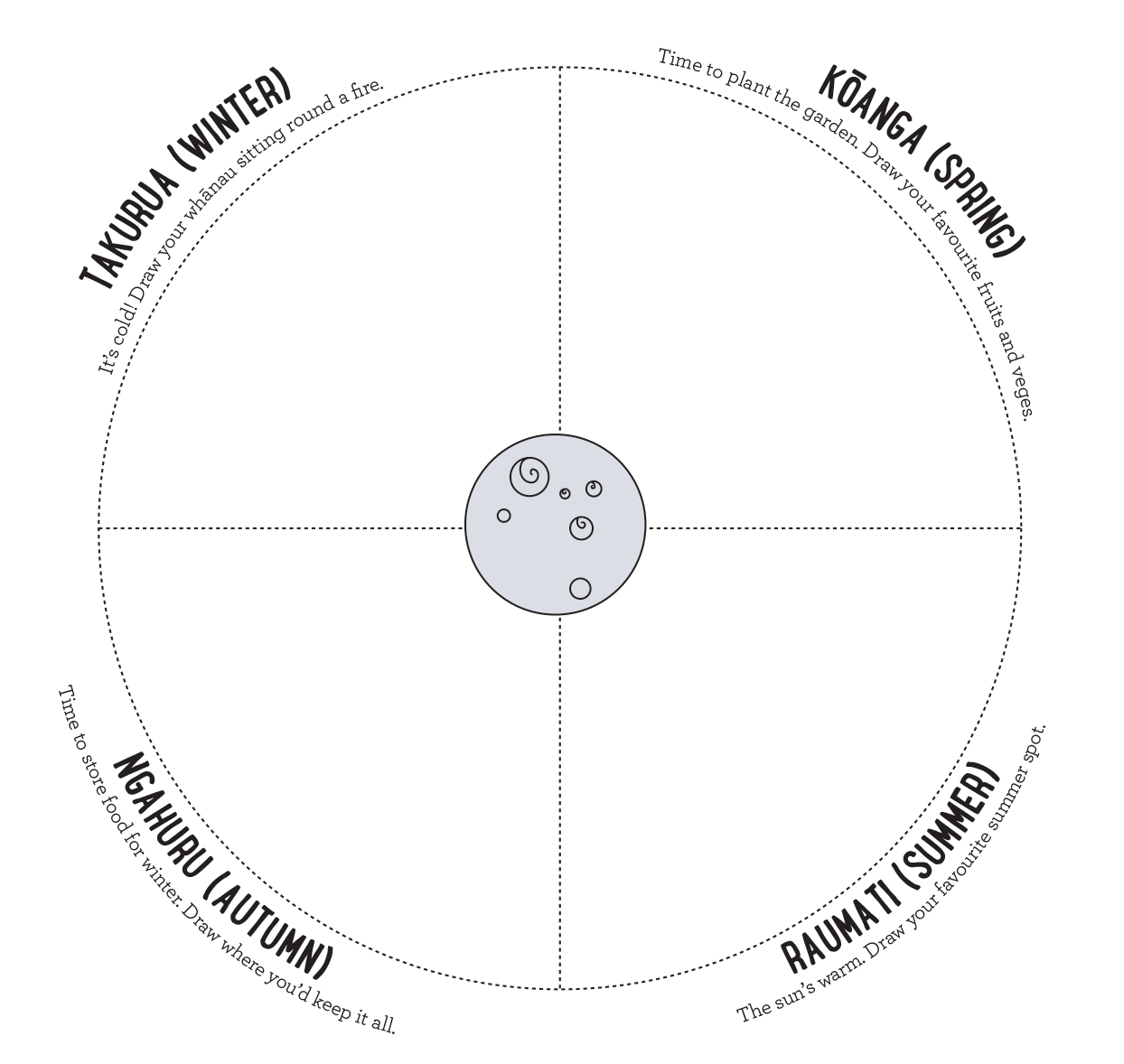
Get growing!
If you can grow your own food, you’ll always have kai to share.
Community gardening teaches you what fruit and veges grow best at what time of year.
This little garden is made from recycled cans.
Activity
Draw a plant you could grow in each season.
Some plants you could draw!
Carrot
Lettuce
Brocolli
Strawberry
Native plants
Māori used native plants for everything from food and rongoā (medicine) to weaving and carving.
Joseph Banks and Daniel Solander came to Aotearoa New Zealand on the Endeavour and collected seeds and plants. Many hadn’t been seen by Europeans before.
Activity
Find a plant specimen and draw or paste it.
What plant is that? Is it native? Find out here:
Note these details about the plant including the date you collected it:
ingoa — name
ingoa o te tupu — plant specimen name
rā — date.
Our history, places and treasures
Small country, big events
The signing of the Treaty of Waitangi was an important event in the history of Aotearoa New Zealand.
But a lot happened before that!
Activity
Match the milestone to the date. Put these events in the correct order.
Milestones
Northern Māori sign He Whakaputanga, declaring the country an independent Māori nation.
Settlers from the Pacific begin migrating here over many generations.
Kupe comes to Aotearoa.
Abel Tasman is the first European to sight Aotearoa.
Lieutenant James Cook arrives on the Endeavour.
The first shipload of European settlers arrives.
The Treaty of Waitangi was signed.
Dates
2019
1840
1837
1835
1831
1814
1791–1792
Late 1700s
1769
1642
1150
925
Our treaty
The Treaty of Waitangi is our founding document — an agreement between Māori and Pākehā to live together in peace.
Activity
True or false?
The Treaty was only signed at Waitangi.
The English and Māori versions were exactly the same.
The Treaty was written super fast — in just one night.
No women signed the Treaty.
The original copies of the Treaty are at the National Library.
Answers — see Answers, glossary and acknowledgements.
The sheets
The Treaty isn’t just one document.
It was signed on nine separate ‘sheets’.
Activity
Which one is which?
Match the image to its name.
The Waitangi Sheet
The Manukau-Kāwhia Sheet
The Waikato-Manukau Sheet (the only sheet written in English)
The Printed Sheet
The Tauranga Sheet
The Bay of Plenty (Fedarb) Sheet
The Herald (Bunbury)
The Cook Strait (Henry Williams) Sheet
The East Coast (Turanga) Sheet.
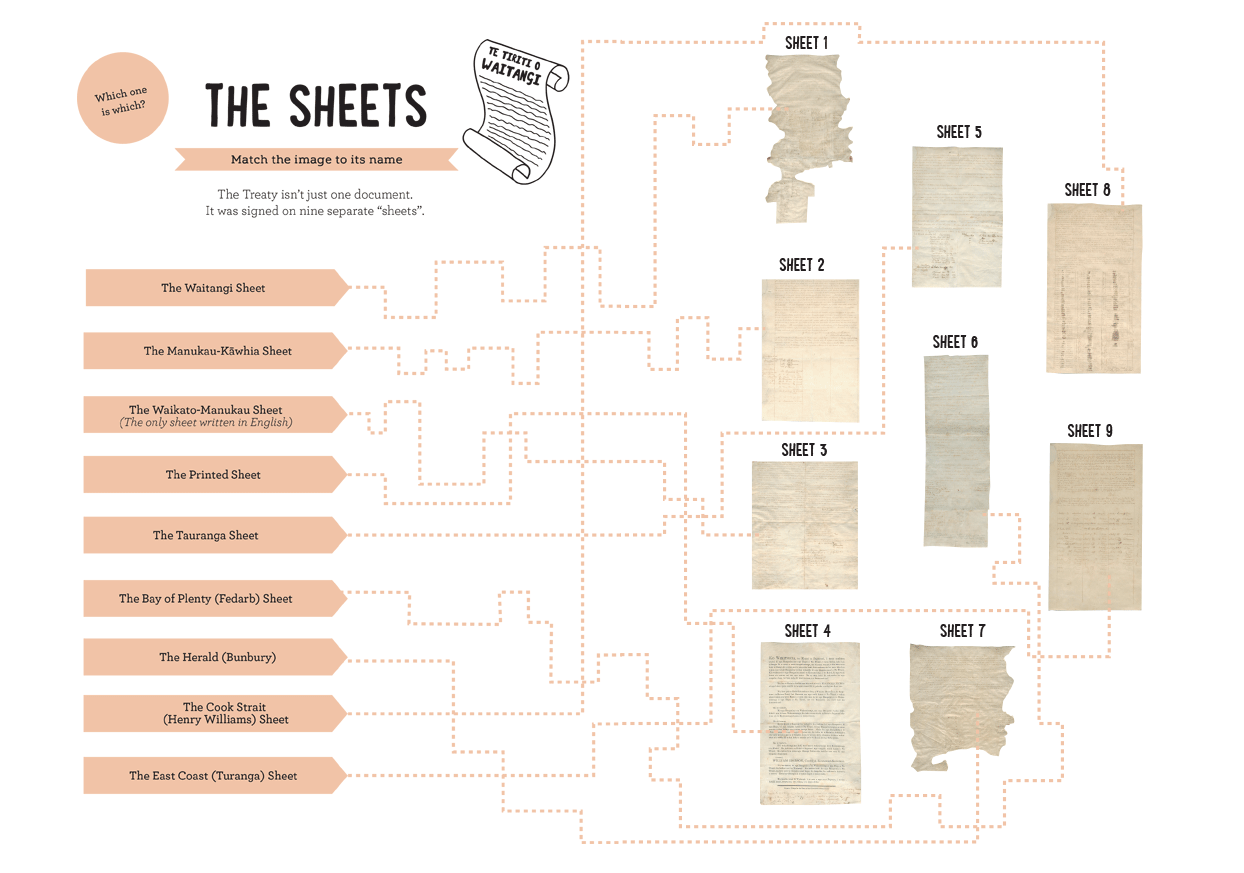
Place names
Place names tell you where you are, and who was here before you.
Activity
Write the name of the place you live.
Write two things you like about your place.
My place
Tell a story about something amazing that happened in your town a long time ago — comic strip style!
Taonga — your treasures
Taonga are treasured objects. They can remind us of special people or places.
What taonga would you take with you to a new home?
Activity
Visit your local museum.
Draw or paste a photo of your special taonga.
Stars of today and tomorrow
Stars of today
You can help nature thrive. The environment keeps us alive.
How can you nurture it in return?
Activity
Tick what you’ve done already:
Turn the tap off while brushing your teeth.
Reuse things in another way.
Recycled in your recycling bin.
Planted a tree.
Stars of tomorrow
New Zealand is a country of innovators and explorers.
What are your bright ideas? Draw them into one of the stars.
The future holds exciting possibilities.
Be a star. Make it happen.
Answers, glossary and acknowledgements
Our treaty — answers
False — it was taken around the country.
False — they made different promises about who had power over what.
True.
False — about 13 women signed it.
True.
Glossary
Maramataka — Māori lunar calendar.
Tangaroa — god of the sea and fish.
Waka hourua — double canoe.
Matariki — star constellation Pleiades.
Waka hourua
Hiwi — hull.
Kiato — cross-beam.
Manawa — mast step.
Papa noho — deck.
Rauawa — gunwales.
Kei — stern.
Ihu — prow.
Rā matua — mainsail.
Rā taunaki — mizzen.
Hoe tere — steering oar.
Pou manawa — mast.
For more ideas and resources, visit Resources and activities — Tuia Mātauranga.
Acknowledgements
The history of Aotearoa New Zealand has many perspectives, some lesser known than others.
We present some here, and we welcome yours.
Sharing knowledge and hearing different perspectives gives us an opportunity to learn more about the history of Aotearoa New Zealand, the nation’s identity, language and culture, and to help shape the future.
The Ministry of Education would like to acknowledge the contribution of iwi, the waka community, historians, National Library, Land Information New Zealand and resource collections in Te Ara Encyclopedia of New Zealand, Te Papa and NZ History.